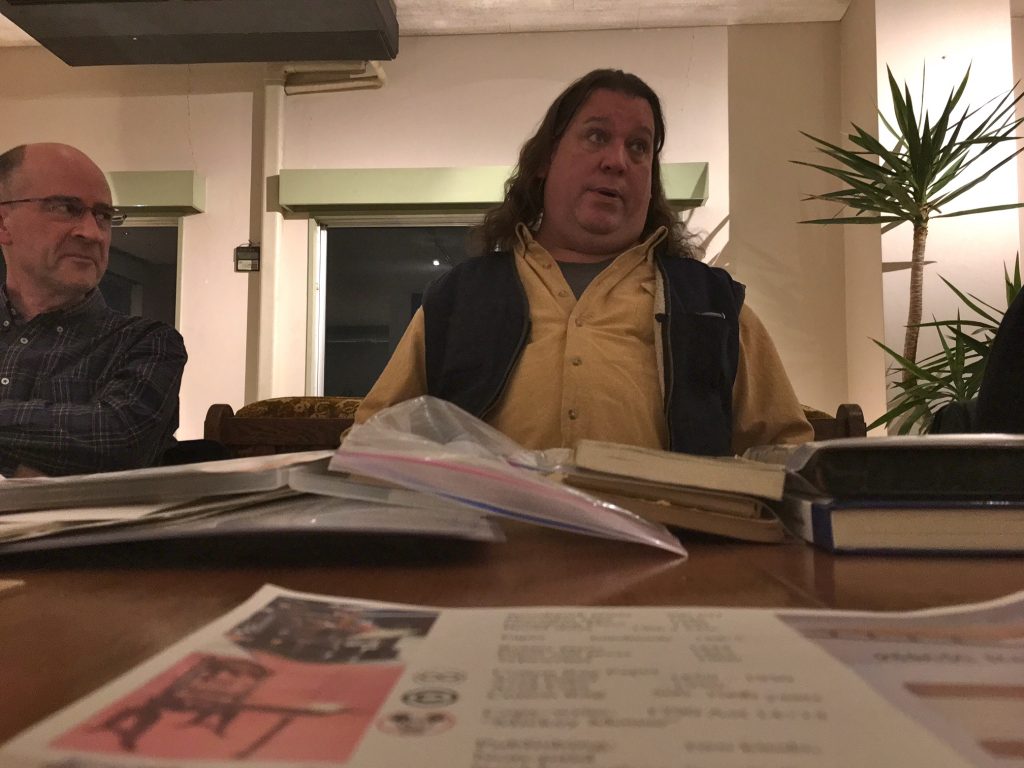
A different view of publishing was provided at an engaging session hosted by WiK member Bernie MacMugen at Cafe Maaru (Dec 11, 2016). In place of the usual author’s perspective, Bernie pronounced himself an unashamed bibliophile with a fondness for hardbacks and no particular interest in writing. Instead he aspires to start his own ‘micro-publishing’ venture, producing specially bound books in limited editions. Among his personal collection of some 3000 books, 75% are hardback. Despite the costs, he makes every effort to hunt down hardback copies where possible because he considers these to be proper ‘books’ with ‘signatures’ stitched together. And what is a ‘signature’?
A signature is a group of pages that are printed on both sides of a sheet of paper. The paper is then folded, cut and trimmed down to the finished page size. The number of pages on a signature depends on your page size and the size of the press sheet they fit on.
Bernie brought an example of a 16-page signature and showed how it could fold into a booklet, with the numbered ordering of the pages something of a revelation to those attending (ten people in all).

The talk was based around an impressive coloured handout (visible in the foreground of the picture above) and began with an overview of publishing history, featuring woodblock prints in 200 AD, Gutenberg’s printing revolution, and the exponential increase in the number of books in the eighteenth and nineteenth centuries following the development of the rotary press and paper roll press.
One topic of particular concern to Bernie as a book collector was ‘acid paper’, which meant that books between the 1850s and 1940’s were prone to deterioration and decay. Only in the 1930s did the problem become evident, so anti-acid measures were taken and by the 1950s all books were acid-free.
Another area of concern for the would-be publisher is copyright, and again he gave a historical view of developments. Around 1680 England introduced copyright for seven years, though this was not enforced in the colonies. In the US copyright protection was introduced in the 1790s for up to 14 years. This was extended in several stages since then, notably in the so-called Mickey Mouse protection law.
Bernie then turned his attention to out of copyright books. One example was a celebrated tea book by A.L. Sadler, first editions of which are extremely rare but which was reprinted by Tuttle – with assertion of copyright. How could they justify that? Apparently by simply adding a Foreword, they could then copyright the whole book as a new edition.
The session closed with a postscript as it were, with Bernie introducing a huge collection of English-language books to which he is privy. Twenty years ago a very rich Japanese eccentric had wanted to set up a bookstore, to which end he travelled to the UK and bought up thousands of classic English Literature works. His plan never came to fruition however, as a result of which the collection is stored unseen in a climate-controlled room. Catalogues have been professionally prepared by a professor Fujita, but as yet there is no sign of a move towards actual sale. This means that anyone with an interest can get a private viewing, and as Bernie suggested this might well make an interesting outing for Writers in Kyoto next year. For expatriates dependent on amazon, this would be a rare and treasured chance to get one’s hands on historical hardbacks – or as Bernie put it ‘real books’.
Our thanks to Bernie for an enjoyable and informative session. And best wishes to our readers for a festive winter solstice and for the coming New Year of the rooster….

